The Problem with Marmite
I recall my wife watching a movie one time, one of the indie, rambling, mumblecorey films she loves where nothing actually happens except a lot of low-key conversations. I was not really paying attention, and I don’t recall the name of the film (and Google has been surprisingly unhelpful in finding it) but I remember a scene at a dinner table, a kind of on-the-nose example of subtext, in which a male character is talking about mustard in sandwiches and states while side-eyeing a female character at the table that, in essence, every sandwich with mustard in it becomes a mustard sandwich.
Note: A deeper dive has revealed that the movie is likely 1997’s The Myth of Fingerprints. Pre-mumblecore but the same kind of awkward drama that she digs.
The point is this: the problem with Marmite is that every sandwich with Marmite in becomes a Marmite sandwich.
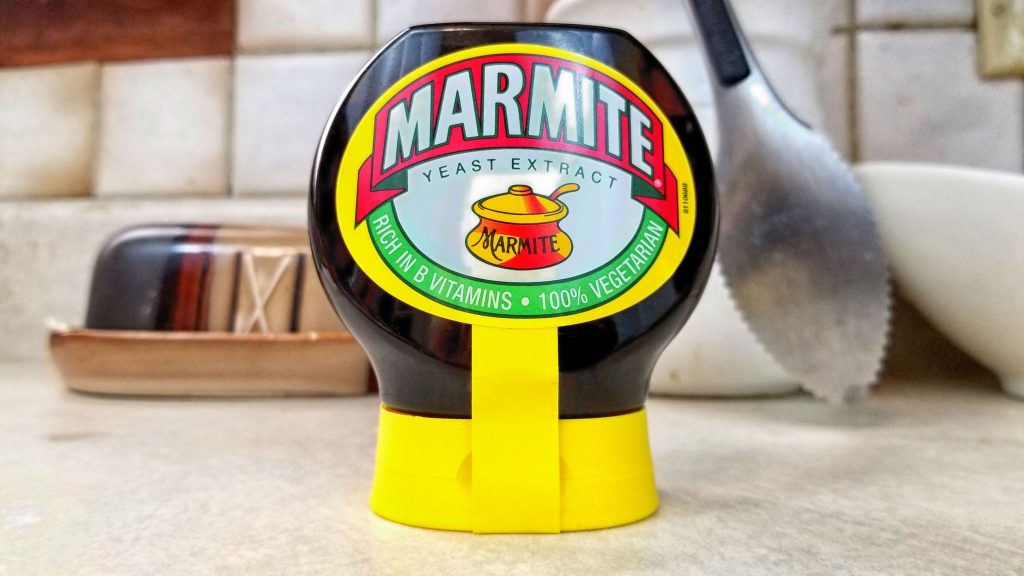
Marmite
Marmite hails from the town of Burton-on-Trent in England. The quality of the water in Burton makes it one of the great brewing centers in the world, and Marmite, made from yeast extract, is in fact a byproduct of that industry. Marmite is a viscous, sticky, dark brown paste with a powerful and salty flavor that doesn’t inspire neutral reactions. “Love it or hate it” goes the slogan.
We’ve tangled once before with Marmite here at the Tribunal, way back in January of 2015 while coming to grips with the concept of the British Rail Sandwich. At that time, I made a Marmite sandwich with cheddar cheese that was universally detested by the entire family (though Damian finished his, mainly out of spite).
And yet, there I was with a jar of Marmite, and somehow over the next few months it slowly disappeared. Intrigued by it, I experimented with simple combinations of Marmite and butter on toast, and eventually I found that if I mixed the Marmite with enough butter, it added an intense savory flavor while retaining the simple crisp-yet-melty charms of hot buttered toast. Damian came to similar conclusions, and between the two of us, we finished the jar. We then finished the squeeze-tube of Vegemite that Tribunal member Crit sent us for no other reason than that she’s terrific.
So here I am again with another jar of Marmite–though a squeeze-jar this time instead of the glass jar of old, much to the consternation of Marmite purists–and Marmite, butter, and toast is still just as great-yet-divisive a combination as ever. If the bread is substantial enough, it doesn’t even need to be toasted, which makes spreading the Marmite thinly enough possible to do without pre-mixing it into the butter.
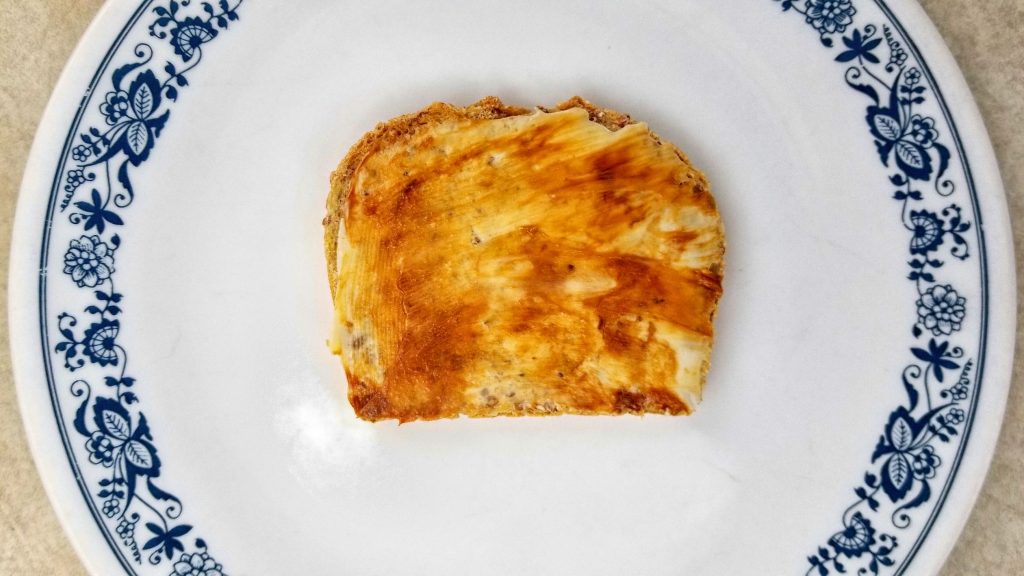
Marmite and butter on a dense multi-grain bread
I still haven’t quite gotten the hang of the Marmite sandwich though. Is that it? Just bread, butter, and Marmite? Given the overpowering flavor of Marmite, we should be able to add just about anything else without changing the essential Marmiteness of the sandwich.
Let’s revisit that Marmite-and-Cheddar sandwich, but this time I’ll use a very strong 8-year-old cheddar, and combat the dryness of the sandwich by adding some sliced tomato.
- Marmite with 8-year cheddar and tomato
- Marmite with 8-year cheddar and tomato
That is a whole lot of sandwich right there. The cheddar is very distinctive, and it isn’t quite fully run over by the flavor of the Marmite. But the Marmite is still the dominant flavor in the sandwich. If anything its flavor is boosted by the additional umami of the rich cheese. The tomato has little say in the final product, but it would be difficult to swallow without it.
If you can’t beat it…
What would be a flavor combination so dominant that it would make the Marmite take a back seat? I contemplated corned beef or pastrami, but I feared the double dose of saltiness either of those cured meats would create with a layer of Marmite. Roast beef, though, along with its natural counterpart horseradish, that’s a rugged enough sandwich to stand up to a little flavor rivalry.
- Marmite with roast beef and horseradish
- Marmite with roast beef and horseradish
And you know, there were several bites of this sandwich where I could hardly detect any Marmite at all. Then I’d hit a section of bread where an air bubble had allowed for a deep pocket of Marmite and you couldn’t get enough horseradish onto a piece of bread to interfere with that.
Not to mention that horseradish and Marmite is not an appealing combination. Don’t try this one at home, folks.
…Join It
I wanted to try one last experiment, to make an actual good sandwich containing Marmite, among other things. Something with good ingredients in an interesting combination, where the Marmite–still front and center, like Marmite tends to be–at least helped the other ingredients reach their potential as well.
I didn’t quite get there, but with some tweaking I think it could work.
Mindy has been visiting a farmer’s market near her office on Thursdays and bringing me a mystery vegetable to play with each week. On this particular occasion, she brought me home a small bunch of leeks. What does one do with leeks? Seems like the thing people make in the main is leek and potato soup. The one time I made leek and potato soup, I thought it was great but Mindy hated it so much that we still laugh about it 17 years later. (It was brave of her to buy me those leeks)
Leeks can be roasted. Leeks can be sauteed. Leeks can be baked in a pie. But the preparation that stood out to me for a leek and Marmite sandwich was braising. I could fry the leeks in my old standby mixture of Marmite and butter, then simmer them with a braising liquid until tender, then serve them in a sandwich with, I don’t know, something. I’ll get to that.
What to use for the braising liquid though? As it happened, I had something else from Burton-on-Trent that seemed perfect.
No, not beer.
Bovril is an English broth mix, popular as a hot beverage in the UK during soccer games (sorry, football matches). Of course, the beef flavor is the thing over there, but it turns out you can’t really buy British beef products in the US. I like the chicken flavor just fine.
The leeks fried in the Marmite-and-butter mix for 3-4 minutes per side, then simmered in a cup of chicken Bovril for another 20 minutes while I decided what else should go in the sandwich. I decided on mayonnaise spiked with lemon juice, red lettuce leaves, and boiled eggs.
And here’s the thing. This almost worked. The Marmite leeks were just a little too overpowering. I should have used less of them and more of the mayo.
So what have I learned?
Not a damn thing. I’ll spend the next 6 months or so working my way through this bottle, one piece of toast at a time, maybe adding a little dab to sauces here and there for a bit of an umami boost, like one would with soy sauce. Some flavors just don’t play well with others, and not everything needs to be sandwichized.

I like sandwiches.
I like a lot of other things too but sandwiches are pretty great






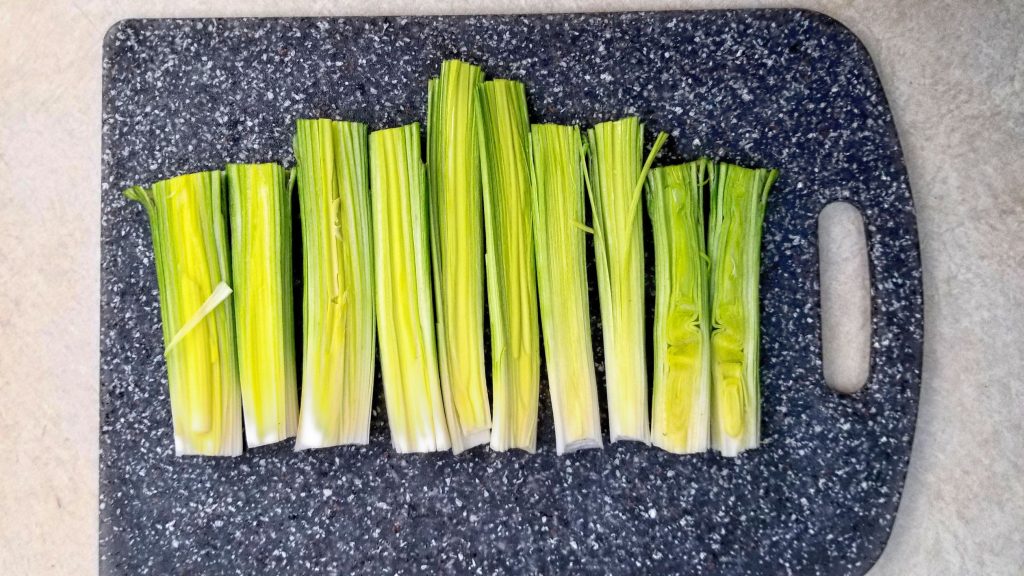
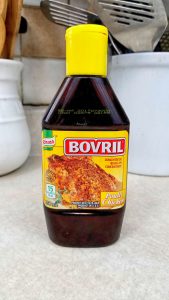
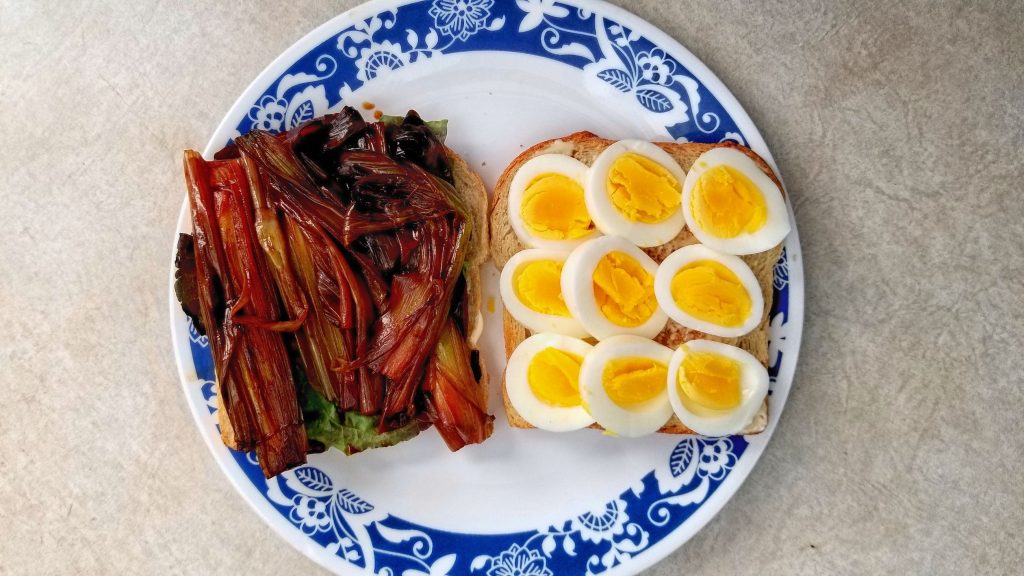









personally, i love marmite, but i also eat miso spread on bread, so, take that into account.. BUT as for what to do with leeks, i’ve begun making coconut braised curry leeks, which i use as a base for fish. basically slice a ton of leeks, saute slowly in oil (any kind, though coconut oil adds more coconutty goodness), add curry powder and let get nice and soft and slightly browned. pour in some coconut milk and let it reduce. add more if needed, but you basically want creamed leeks, not leeks in coconut sauce. then i either pan fry some salmon filets so i get nice crispy skin and serve it over the leeks or, if i’m feeling lazy, i throw the salmon on top of the leeks, cover it and let the salmon braise till it’s cooked. really good.
Try marmite and spam.
Try Marmite and Peanut Butter sandwich. Lots of butter or good margarine, then thin marmite and lots of crunchy peanut butter, fold over (important!!).My mouth waters in anticipation when making these!!
I love Marmite, butter on toasted Hawaiian bread. The sweetness of the bread balances the saltiness and powerful flavor of Marmite.
You knob. You can’t beat a horseradish and marmite buttie. Beef and horseradish go so why you reckon this doesn’t. Especially nice dipping in tomato soup. Mmmm